The 2022 Chevrolet Bolt EUV is an all-new electric vehicle that builds on the success of the Chevrolet Bolt EV, with a 6-inch (15.2 cm) longer overall length and a crossover-style body. Both the 2022 Bolt EUV and 2022 Bolt EV (Fig. 1) feature a new interior, a number of innovative features and sleek exterior designs, while sharing the same 65kWh nickel-lithium-ion high-voltage battery pack.
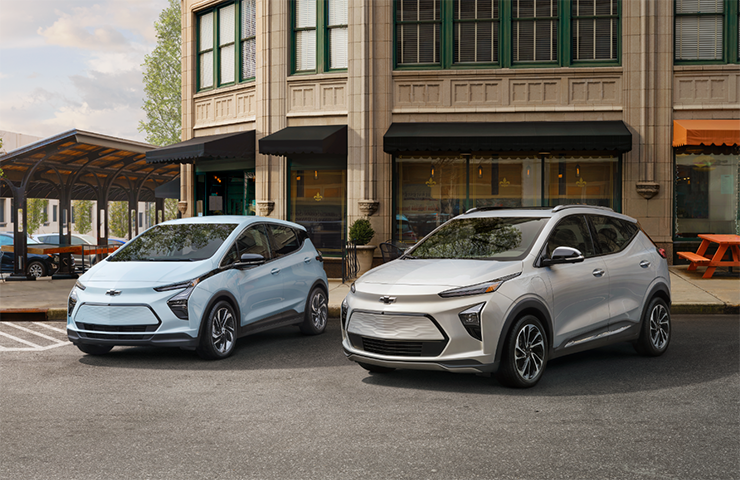 Fig. 1
Fig. 1
Both vehicles share an all-electric front-motor, front-wheel-drive, 5-passenger, 4-door design. The new Bolt EV is available in two trim levels: 1LT and 2LT, while the Bolt EUV is available in three trim levels: LT, Premier, and the limited Launch Edition.
The new design of both vehicles features an advanced high-strength steel frame and aluminum enclosures on the front fender, hood, door and liftgate for increased efficiency. The cabin has a 10.2-inch (259 mm) color touchscreen mounted in the center stack and a driver-facing 8.0-inch (203 mm) color digital gauge cluster. (Fig. 2)
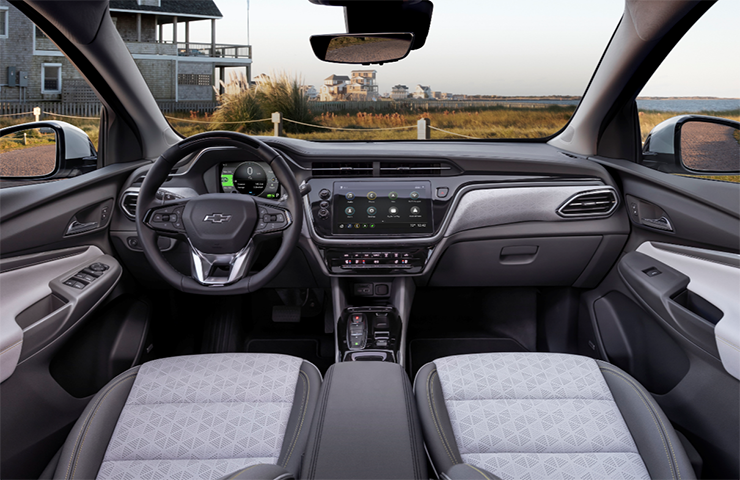 Fig. 2
Fig. 2
Propulsion System
The Bolt EV and Bolt EUV are equipped with a 65-kWh nickel-rich, lithium-ion high-voltage battery. It weighs approximately 946 pounds (429 kg) and is an integral member of the vehicle’s BEV II chassis (Fig. 3), improving torsional rigidity by nearly 30 percent over the previous Bolt EV model.
 Fig. 3
Fig. 3
The propulsion of the vehicle is achieved by a front-wheel drive, variable-speed 1ET25 automatic transmission (RPO MMF) and a permanent magnet 150-kWh drive motor controlled by a power inverter module, which provides torque for vehicle propulsion and regenerative braking. The Bolt EUV retains drive unit cooling using the power electronics coolant loop. The Bolt EV eliminated the drive unit cooler and hoses.
The Bolt EV offers an EPA-estimated 259 miles (417 km) of range per full battery charge and the Bolt EUV offers an EPA-estimated 247 miles (397 km) of range per full battery charge. Three range estimates are displayed on the instrument cluster: a maximum, a minimum, and a more prominent best estimate based on the individual’s driving style. Accessory usage, such as climate control settings and heated seats, as well as outside ambient conditions have a large effect on overall range.
One-Pedal Driving
The electronic shifter features a push/pull switch operation. Park and Neutral require a button push while Reverse and Drive require a button pull. There is not a Low (L) selection. (Fig. 4)
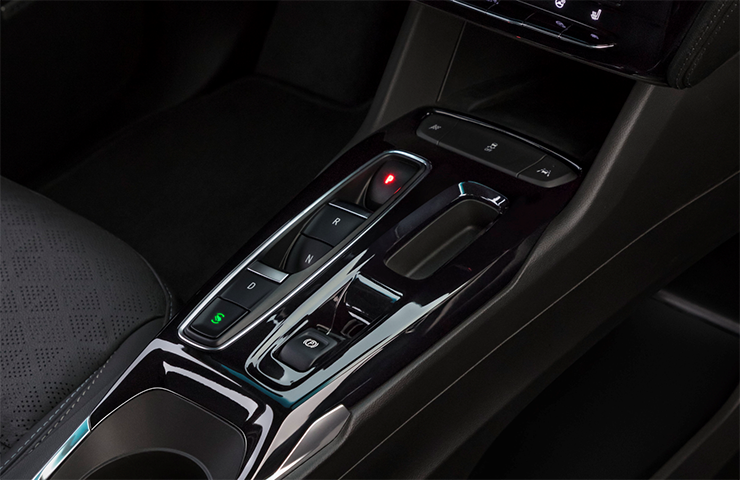 Fig. 4
Fig. 4
At the bottom of the electronic shifter is the One-Pedal Driving button that turns on the One-Pedal Driving mode, which helps the vehicle generate and capture greater amounts of energy that is used to charge the high-voltage battery during deceleration. One-Pedal Driving mode remains engaged over key cycles.
One-Pedal Driving mode does not eliminate the need to use the brake pedal altogether, especially in emergency situations. Progressively stronger levels of regenerative braking are employed through a series of four driver-selectable modes.
- Operating in Drive and easing off the accelerator. This first level provides the lowest level of regenerative braking and requires the use of the brake pedal to bring the vehicle to a complete stop.
- Operating in Drive and using the Regen on Demand™ paddle on the back of the steering wheel. (Fig. 5) Pulling the Regen on Demand paddle enables the driver to initiate the regeneration process and capture kinetic energy to slow the vehicle and restore energy to the battery.
- Operating in Drive with One-Pedal Driving turned on and easing off the accelerator.
- Operating in Drive with One-Pedal Driving turned on and using the Regen on Demand™ paddle in tandem.
These last three levels are progressively stronger One-Pedal Driving modes that, in certain driving situations, allow a driver to stop the vehicle without using the brake pedal. When in One-Pedal Driving mode, the rear brake lights illuminate automatically and stay on even after the car comes to a complete stop.
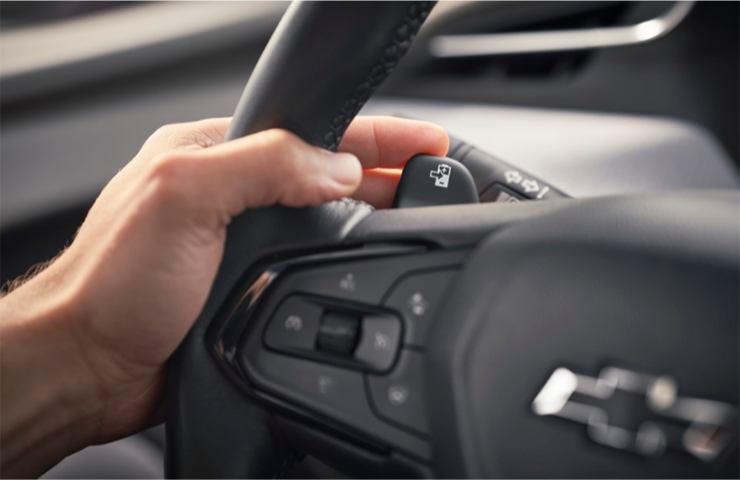 Fig. 5
Fig. 5
One-Pedal Driving will not function if the high-voltage battery is fully or near fully charged, and/or if the battery itself is very cold. The target charge level of the high-voltage battery can be adjusted in the energy screen to ensure that there is ample capacity in the battery to receive charging generated by the vehicle when Regen is active.
Charging the Vehicle
The standard level 1 drive motor battery charger cord included with the Bolt EV is capable of plugging into a standard 120V household electrical plug. Charge rates are either 8 amps or up to 12 amps. (Fig. 6)
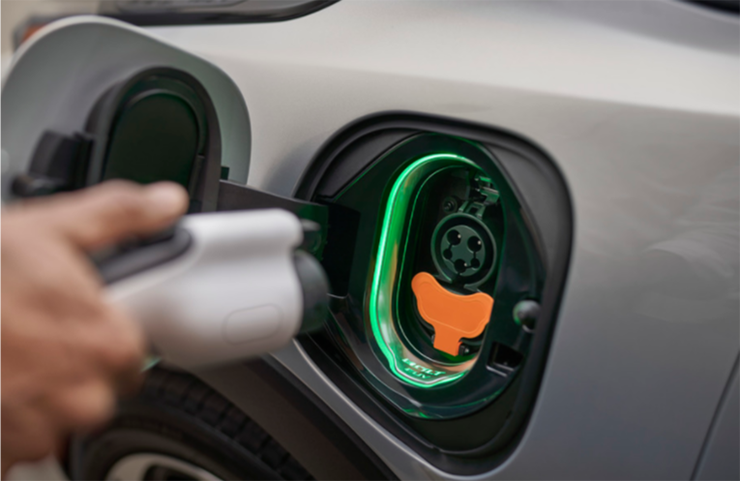 Fig. 6
Fig. 6
A dual-mode drive motor battery charger cord, or dual-level charge cord, (RPO EKT) is standard equipment for the Bolt EUV and is optional for the Bolt EV. It features a swappable 120V standard household electrical plug and a 240V NEMA 1450 electrical plug, allowing for level 1 and level 2 charging. The charger also features a charge current interrupt device with AC power and fault indicators.
TIP: If the pluggable cord set is not fully seated, the amber light will glow and the charger will not function. Fully seat the cord set. (Fig. 7)
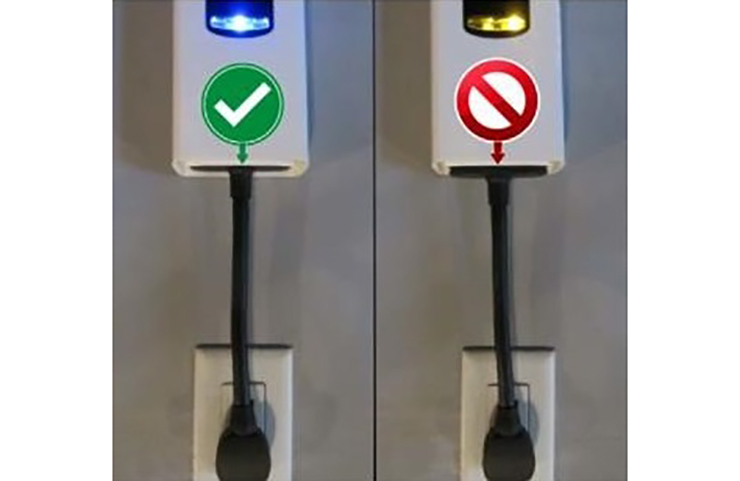 Fig. 7
Fig. 7
The charging system may run fans and pumps that result in sounds from the vehicle when it is turned off. Additional unexpected clicking sounds may be caused by the electrical devices used while charging. The Content Theft Deterrent system arms when the cord is plugged in and the vehicle is locked only when using level 1 charging.
Driver/Energy Information
The instrument cluster layout can be changed using the right steering wheel controls. There are two main cluster display configurations. The information on the left side of the Driver Information Center on the cluster generally provides battery and range information and the right side provides driving efficiency information. (Fig. 8)
 Fig. 8
Fig. 8
The driving scorecard rates things like driving technique, climate control usage, terrain and outside temperature. The range displayed in the vehicle is a prediction based on past driving conditions (kWh of energy used per distance traveled), current ambient temperature, and climate control settings. It is normal for the displayed value to adjust while the vehicle is being driven as this number is constantly being recalculated to provide the best estimate of electric range. The 2022 Bolt EV and EUV provides helpful energy graphic displays and information in the center stack energy screen, or “leaf screen”. (Fig. 9)
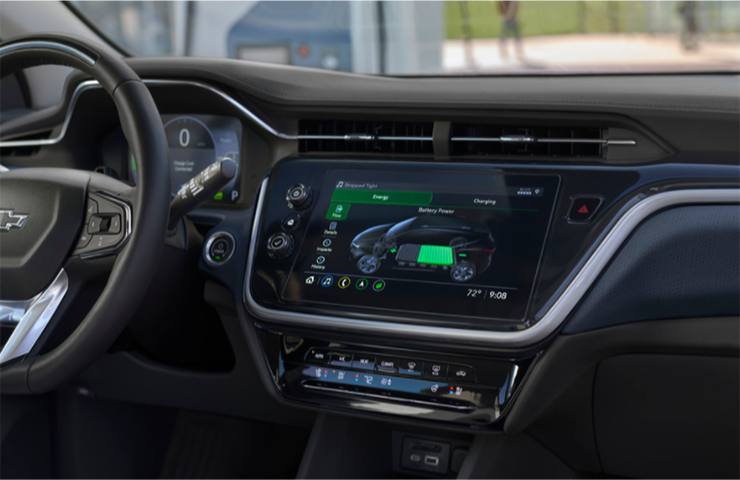 Fig. 9
Fig. 9
Driver Assistance
The 2022 Bolt EV and Bolt EUV include the Chevrolet Safety Assist package as standard equipment. It includes Automatic Emergency Braking, Forward Collision Alert, Front Pedestrian Braking, Following Distance Indicator, Lane Keep Assist with Lane Departure Warning and IntelliBeam auto high beams.
Additional available safety features include HD Surround Vision, Lane Change Alert with Side Blind Zone Alert, Rear Cross Traffic Alert and Rear Park Assist.
Tires
The vehicles are equipped with Michelin self-sealing tires. The vehicles do not come with an inflator kit (with the exception of vehicles sold in Rhode Island and Canada).
For additional information on the new 2022 Bolt EUV and Bolt EV, refer to Bulletin #21-NA-141.
– Thanks to Jonathan Johnson and Matt Bunting


















